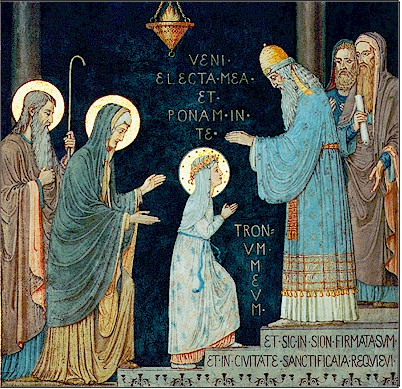I & II Vespers: 9th
Century
Walpole: Blume {Analecta LI p. 47) says that the
contents of this hymn apply less to the Advent season than the other Advent
hymns, perhaps it was not originally meant for Advent. Walsh & Hatch: It is
allocated to Advent in view of stanza 3.
Cónditor
alme síderum, (1)
ætérna
lux credéntium,
Christe,
redémptor ómnium,
exáudi
preces súpplicum.
Qui
cóndolens intéritu (2)
mortis
períre sæculum,
salvásti
mundum lánguidum,
donans
reis remédium,
Vergénte
mundi véspere, (3)
uti
sponsus de thálamo, (4)
egréssus
honestíssima
Vírginis
matris cláusula.
Cuius
forti poténtiæ
genu
curvántur ómnia; (5)
cæléstia,
terréstria
nutu
faténtur súbdita.
Te,
Sancte, fide quæsumus,
ventúre
iudex sæculi,
consérva
nos in témpore
hostis
a telo pérfidi.
1. Walpole: slderum the heavenly bodies, including
the sun and moon. The word strikes the
keynote of the hymn, forecasting the light which Christ, Himself the eternal
light, was to bring into the world.
2. WH:
interitu mortis: "In
the extinction of death," the moral death incurred by Adam's sin.
3. Walpole: ' When the
world's evening was drawing to a close,'; WH: The coming of Christ is
visualized as the end of the old world and the beginning of the new. See Hbr
9:26: "He has appeared once for all at the end of the age to remove sin by the sacrifice of
himself"
4. WH: evocation of Ps 18:6,
"tamquam sponsus procedens de thalamo suo" (as a bridegroom coming out
of his bridechamber).
5. So Phlp 2:10-11: "Ut
in nomine Iesu omne genu flectat caelestium, terrestrium et infernorum, et
omnis lin-gua confiteatur quia Dominus Iesus Christus in gloria est Dei
Patris."
O kind Creator of the stars, eternal light of the
faithful, Christ, redeemer of all men, hear the prayers of those who humbly
entreat you. Who grieve that through the ruin of death the world should perish,
did save the sick world, granting a remedy to the guilty. When the world drew
near to evening, as a bridegroom going forth from the wedding bed, you came
forth from the virgin mother’s most honorable womb. Before your strength of
power, all in heaven and earth must bend the knee and confess that they are
subject to your command. We beseech you, O Holy one, who will come to judge the
world, preserve us in the present time from the darts of the perfidious enemy.
Lauds: 10th
Century
Walpole: This hymn was generally appointed for
Matins in Advent, but according to date and locality its use varied. Thus in
the Mozarabic breviary it was sung at Vespers on the Wednesday infra hebdomadam I Adventus {Analecta
XXVII. p. 65). It is largely based on the Advent Epistle Rom. xiii. 1 1 f. and
Gospel Lk. xxi. 25 f.
Vox
clara ecce íntonat, (1) (2)
obscúra
quæque íncrepat:
procul
fugéntur sómnia;
ab
æthre Christus prómicat.
Mens
iam resúrgat tórpida
quæ
sorde exstat sáucia;
sidus
refúlget iam novum, (3)
ut
tollat omne nóxium. (4)
E
sursum Agnus míttitur (5)
laxáre
gratis débitum;
omnes
pro indulgéntia (6)
vocem
demus cum lácrimis,
Secúndo
ut cum fúlserit
mundúmque
horror cínxerit,
non
pro reátu púniat, (7)
sed
nos pius tunc prótegat.
Summo
Parénti glória
Natóque
sit victória,
et
Flámini laus débita
per
sæculórum sæcula. Amen.
1. Walpole: The voice is that
of the Baptist, the forerunner of Christ, Joh. i. 23.
2. intonat 'resounds loudly'
3. sidus i.e. Christ. ' Morning Star' of Rev. xxii. 16.
4. noxium ‘guilt’
5. sursum ‘from on high’;
6. pro indulgentia ‘for pardon’
7. pro reatu ‘ according to our guilt’
Now the loud voice of the Baptist thunders, all
darkness is rebuked; sleep flees afar, Christ shines forth from heaven. Now the
sluggish mind, still wounded by impurity, awakes, already a new star shines to
take away all harm. From heaven a Lamb is sent to free us from our debt, let us
all weep and cry out for pardon. That when for a second time he shines and
horror grips the world, he will not punish us
for our guilt but in his holiness protect us. To the highest Father
glory, to the Son victory, to the flaming Spirit due praise through all ages. Amen
When the Office of
Readings is said in the daytime: 10th Century
Milfull;
use Matins or Lauds
Verbum
supérnum pródiens, (1)
a
Patre lumen éxiens,
qui
natus orbi súbvenis
cursu
declívi témporis: (2)
Illúmina
nunc péctora
tuóque
amóre cóncrema;
audíta
per præcónia (3)
sint
pulsa tandem lúbrica.
Iudéxque
cum post áderis
rimári
facta péctoris,
reddens
vicem pro ábditis
iustísque
regnum pro bonis,
Non
demum artémur malis (4)
pro
qualitáte críminis,
sed
cum beátis compotes (5)
simus
perénnes cælites.
1. St. Thomas Aquinas borrows
this line for the beginning of his famous Eucharistic hymn.
2. Walpole: the writer takes the N.T. view that the incarnation came in the
end of the world's history; declívi ‘sloping
towards evening, as if the sun were past its zenith
3. audita... praeconia i.e. when Thy coming is proclaimed as it were by
a herald (praeco).
4. ' Oh let us not be punished
according to the heinousness of our guilt.'
5. Compotes ‘of the number of those of who have obtained’.
The Word proceeding from on high, the Light coming
from the Father, born to rescue the world at the end of time. Enlighten now our hearts burning with your
love, when the proclamation is heard, finally deceit is driven off. And when
you come as our judge to search out the deeds of the heart, rendering to each for hidden sins, and the
kingdom to the righteous for good deeds.
In the end may we not be crushed for the quality of our evil sins but in
the company of the blessed we may be
eternally citizens of heaven.




